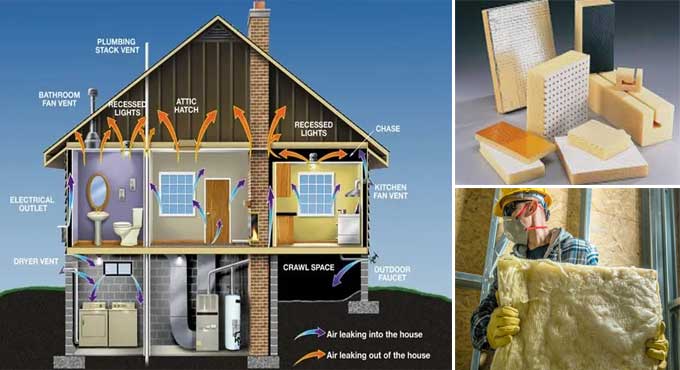
Thermal Insulation Materials Types in Buildings Construction in 2023

It is also important to note that thermal insulation is used in hot climates. As a result, their insulation minimizes the flow of heat from the outside into the house. Therefore, thermal insulation minimizes the heat flow from the inner to the outer of the building or from the outer to the inner of the building.
The building owners must also thermally insulate the building to ensure the heating system works efficiently. Thermal insulation minimizes the heat escaping from the building & the building can stay warm with less effort.
Define Thermal Insulation in Buildings
Heat is prevented from flowing through buildings by thermal insulation. In many parts of the country, the winters are extreme, so people have to keep their homes warm. In order to maintain the home's temperature, they light fires inside, use heaters, and use steam to maintain the temperature.
Define Thermal Insulation Materials
Providing thermal insulation to a building requires thermal insulation materials. A wide variety of materials can be used for thermal insulation, including mineral wool, sawdust, reflective cladding sheets, fiberglass, cellulose, polyurethane foam, polystyrene, etc.
To minimize the amount of heat transferred through radiation, conduction, or convection, insulating materials rely on the molecular makeup of the material.
The thermal resistivity of dense, self contained cellular insulation materials is greater than that of open cell insulation materials, which require dry air within their cores for optimum performance.
Thermal Insulation Materials Types
Mineral Wool
There are two kinds of mineral wool: rock wool, which is made from basalt and slag wool, which is made from blast furnace slag. An average of 75% of its material is recycled from post-industrial sources. In addition to being eco-friendly, it is manufactured from recycled materials.
As it is incombustible and does not melt, it does not require additives to make it fire-resistant. Nevertheless, extreme temperatures should not be reached with this product while using.
Polyurethane Foam
An application of polyurethane foam with a spray gun makes it lightweight and waterproof. Filling cracks and filling spaces around pipes is easy with this material.
However, polyurethane foam installations are costly compared to fiberglass or cellulose insulations because of its higher costs. A disadvantage of polyurethane is that it is not recyclable and, therefore, not sustainable, and also flammable.
Polystyrene
A thermoplastic material made from small plastic beads that have been melted together, expanded polystyrene is commonly known as EPS. Foam boards and microscopic foam beads are commonly made from MEPS, which is molded expanded polystyrene. The name Styrofoam refers to molten polymers pressed into sheets that are called extruded polystyrene.
Fiberglass
Fiberglass is one of the most commonly used insulation materials made from very thin strands of glass. Minerals such as sand, soda ash, limestone, and recycled glass are used to make fiberglass. The content of recycled glass must be at least 35% for fiberglass to be considered green.
Cellulose
Approximately 85% of cellulose is made from recycled paper goods, primarily newspapers. Insulation made from loose-fill material is frequently used for blow-in insulation.
Thermal Insulation Types
Blanket Insulation
Mineral wool, cotton, processed wood fiber, and animal hair are all types of flexible fibrous materials used in insulating blankets. Paper rolls or blankets similar to them can be purchased.
It is also easy to install blanket insulation since it can be directly distributed over the wall or ceiling surface and held in place by insulation fasteners. There is a range of 1 to 8 centimeters in thickness & they are bendable.
Batt Insulating Materials
In addition to batt insulation rolls, blanket rolls are also available. However, blanket rolls are thicker than batt insulation rolls. A blanket installation is similar to that of batt insulation. Room ceilings or walls can also be covered with these.
Structural Insulated Panels
Using foam board, a liquid foam insulation core, and straw insulation, structural insulated panels are prefabricated insulated components. House walls, floors, ceilings, and roofs are constructed with them. Oriented strand board is sandwiched between two sheets of 4 to 8 inch foam board insulation.
Compared to traditional construction methods, SIPs offer superior and uniform thermal insulation, resulting in energy savings of 12 to 14 percent. The strength to weight ratio of Structural Insulated Panel is high.
Insulating Board
A combination of nature and technology, insulating boards provide warmth and comfort. For making these boards, wood pulp, cane pulp, or other materials are pressed very firmly at an appropriate temperature with some force.
Due to their finished surface, they have a nice appearance as well as excellent insulation properties. Wall linings and partition walls are typically constructed with insulation boards.
Lightweight Materials
It is beneficial to use low-weight aggregates when producing concrete mixtures since they will also prevent heat loss. It is recommended to use lightweight aggregates that are resistant to heat, such as blast furnace slag, vermiculite, and burnt clay aggregates.
To learn more, watch the following video tutorial.
Video Source: CertainTeed
Block or Slab Insulation
These blocks are made from materials including mineral wool, corkboard, cellular glass, and cellular rubber. Heat is minimized and the desired temperature is maintained by fixing these to the walls and roofs. A 60 by 120 centimeter plank with 2.5 centimeters of thickness measures 60 centimeters by 120 centimeters.
Loose Fill Insulation
In the insulation industry, loose-fill insulation refers to materials not packaged in a standard way. A wide variety of materials, including mineral wool, cellulose, rock wool, can be purchased in loose form on the market. Moreover, the cavity should be filled with any loose material. The easiest way to install loose fill insulation is to cut a stud in the wall where windows and doors will go.


